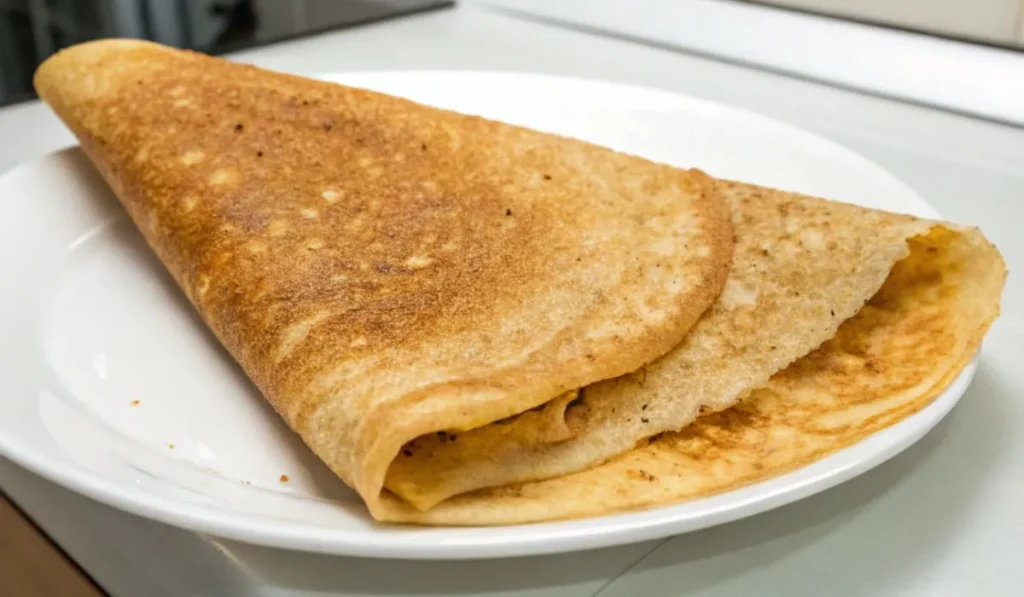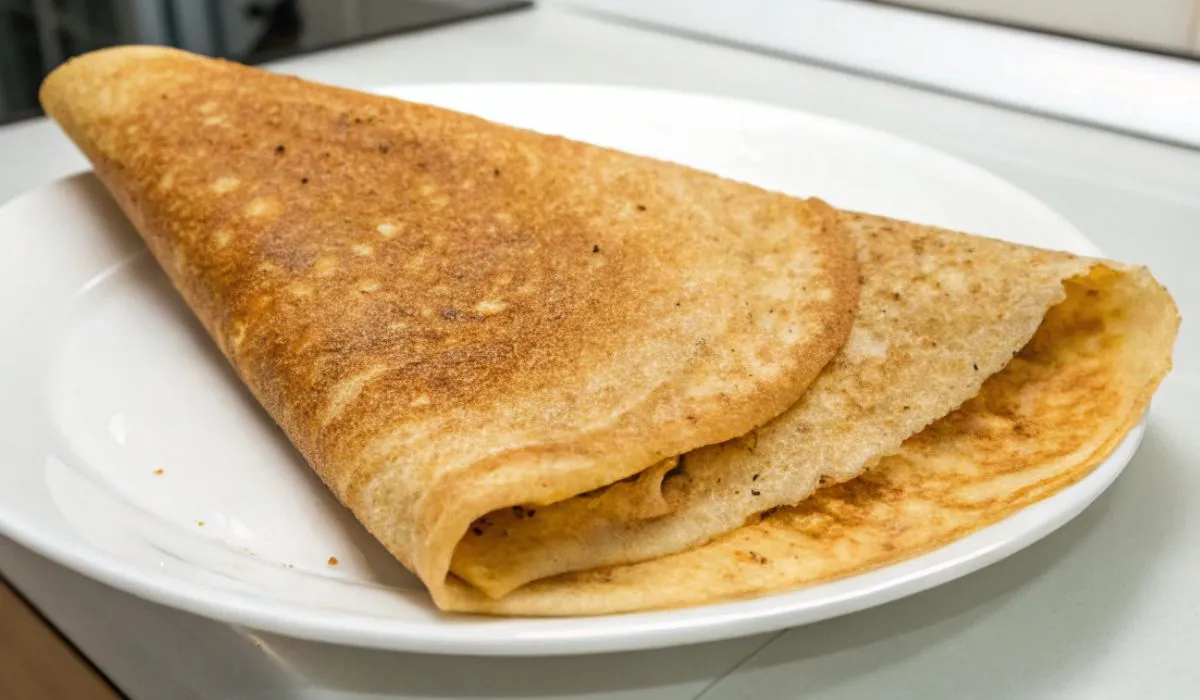This authentic dosa recipe will help you create golden, crispy South Indian crepes that rival any restaurant version. After making dosas for over a decade in my kitchen, I’ve perfected this traditional method using fermented rice and lentil batter.
These thin, savory pancakes make an incredible breakfast or snack when served with coconut chutney and sambar. The fermentation process creates the signature tangy flavor and airy texture that makes dosas so special.

Essential Ingredients for Perfect Dosa Batter
These simple ingredients come together to create the perfect fermented batter for authentic South Indian dosas:
- 1/2 cup idli rice or parboiled rice
- 1/2 cup regular white rice
- 1/4 cup urad dal (black gram lentils)
- 1/8 teaspoon fenugreek seeds
- 2 tablespoons thick poha (flattened rice)
- 1.5 cups water for soaking
- 3/4 cup water for grinding
- 1/2 teaspoon rock salt or sea salt
- Oil for cooking
Step-by-Step Dosa Making Instructions
Follow these simple steps to create authentic South Indian dosas with perfectly fermented batter:
- Combine and rinse ingredients. Mix both types of rice with urad dal and fenugreek seeds in a large bowl. Rinse everything together several times until water runs clear.
- Add poha. Rinse the flattened rice once in a separate bowl, then add it to the rice mixture.
- Soak everything. Pour 1.5 cups water over all ingredients and mix well. Cover and soak for 4 to 5 hours.
- Grind the batter. Drain soaking water and transfer ingredients to a blender. Add 2/3 to 3/4 cup fresh water and grind until smooth with slightly grainy texture.
- Add salt and ferment. Transfer batter to a large bowl, add rock salt, and mix thoroughly. Cover and ferment for 8 to 9 hours at room temperature.
- Heat the pan. Warm a cast iron pan over medium-low heat. Spread 1/4 teaspoon oil evenly across the surface.
- Spread the batter. Pour one ladle of batter onto the center of the pan. Quickly spread in circular motions from center to edges.
- Cook until golden. Cover with a lid and cook on low to medium heat. When the bottom turns golden and edges lift, sprinkle oil around the edges.
- Fold and serve. Once the dosa releases easily from the pan, fold in half with a spatula and transfer to serving plate.
Pro Tips for Dosa Success
- Temperature control makes the biggest difference in dosa making. I always keep my pan on medium-low heat to prevent burning while ensuring even cooking. If your pan gets too hot, the batter won’t spread properly.
- Batter consistency should be pourable but not too thin. If your batter becomes watery, add a tablespoon of rice flour to thicken it. This tip has saved many batches in my kitchen.
- Fermentation depends heavily on climate conditions. During summer months, 8 hours usually works perfectly. In winter, I sometimes need 12 to 14 hours for proper fermentation. The batter should smell slightly sour and show visible bubbles.
Fermentation Tips for Different Climates
- Cold weather fermentation requires extra attention. I place my batter bowl near a warm spot like the oven with just the light on. Adding a pinch of sugar helps speed up the process during winter months.
- Instant Pot users can use the yogurt setting on low mode for 8 to 12 hours. This method works wonderfully for consistent fermentation regardless of outside temperature.
- High altitude cooking may need longer fermentation times. I recommend checking the batter every few hours and looking for the telltale signs of proper fermentation.
Storage and Serving Suggestions
Fresh dosa batter stays good in the refrigerator for 2 to 3 days. You can also freeze portions for up to one week. Always thaw frozen batter completely at room temperature before use.
Serve your homemade dosas immediately while they’re hot and crispy. Traditional accompaniments include coconut chutney, sambar, and potato masala. The contrast between the crispy dosa and creamy chutney creates the perfect bite.
Troubleshooting Common Issues
- Sticky dosas usually mean your pan isn’t properly seasoned or the heat is too high. Make sure to use a well-seasoned cast iron pan or quality non-stick surface.
- Thick dosas happen when the batter is too thick or the pan temperature is wrong. Thin the batter with water and adjust your heat settings.
- Poor fermentation often results from old urad dal, iodized salt, or temperature issues. Always use fresh ingredients and non-iodized salt for best results.
This traditional dosa recipe has been tested countless times in home kitchens across different climates. With practice, you’ll develop the rhythm and technique that makes restaurant-quality dosas achievable at home.

Easy Dosa Recipe
Ingredients
Equipment
Method
- Combine and rinse ingredients: Mix both types of rice with urad dal and fenugreek seeds in a large bowl. Rinse everything together several times until water runs clear.
- Add poha: Rinse the flattened rice once in a separate bowl, then add it to the rice mixture.
- Soak everything: Pour 1.5 cups water over all ingredients and mix well. Cover and soak for 4 to 5 hours.
- Grind the batter: Drain soaking water and transfer ingredients to a blender. Add 2/3 to 3/4 cup fresh water and grind until smooth with slightly grainy texture.
- Add salt and ferment: Transfer batter to a large bowl, add rock salt, and mix thoroughly. Cover and ferment for 8 to 9 hours at room temperature.
- Heat the pan: Warm a cast iron pan over medium-low heat. Spread 1/4 teaspoon oil evenly across the surface.
- Spread the batter: Pour one ladle of batter onto the center of the pan. Quickly spread in circular motions from center to edges.
- Cook until golden: Cover with a lid and cook on low to medium heat. When the bottom turns golden and edges lift, sprinkle oil around the edges.
- Fold and serve: Once the dosa releases easily from the pan, fold in half with a spatula and transfer to serving plate. Repeat with remaining batter.
